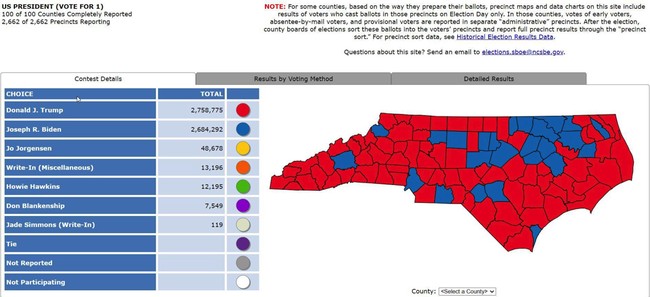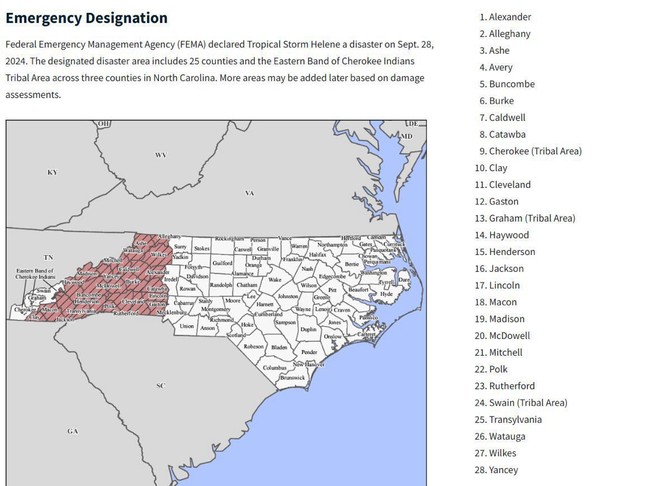It is less than 30 days before the November 2024 election, and thanks to their state elections board, Western North Carolina voters who have been impacted by Hurricane Helene will have more flexibility through vote by mail. On Monday, the North Carolina State Board of Elections (NCSBOE) voted unanimously to allow more flexibility on how collection of ballots and polling locations in these areas will be handled.
Advertisement
The bipartisan State Board of Elections on Monday unanimously approved a long list of emergency measures to help Helene victims vote in the 2024 election and ensure election officials can provide accessible, safe, and secure voting options for residents of Western North Carolina. Read the final, signed resolution (PDF).
The 5-0 vote of Democrats and Republicans on the State Board came after extensive planning by the State Board in coordination with county election officials, public safety and emergency management officials, and the U.S. Postal Service.
These changes, which also include information dissemination on changes to voting in the wake of the disaster, recruitment and assignment of poll workers, implementation of multi-partisan assistance teams, and coordination with emergency officials, will apply to 13 of the 25 counties that fall under the disaster declaration. These counties are: Ashe, Avery, Buncombe, Haywood, Henderson, Madison, McDowell, Mitchell, Polk, Rutherford, Transylvania, Watauga, and Yancey.
Of those 13 counties, 11 of them voted overwhelmingly for former President and GOP nominee Donald Trump in the 2020 presidential election.

The provisions are also designed to help North Carolina voters living temporarily elsewhere inside or outside of the state or in disaster shelters to be able to vote. They also allow county boards of elections in the 13 counties the flexibility to modify early voting and Election Day voting sites and recruit additional poll workers to best accommodate their voters based on local conditions. And they allow election officials to continue to work with federal and state partners to provide election-related aid to the disaster counties, including temporary voting facilities and restrooms, generators, and other needs.
The emergency measures also include ways to get information about voting to voters housed in shelters and to western North Carolina in general. They were carefully crafted to avoid any detrimental effect on the integrity of the election or the security of ballots.
Advertisement
What a concept: an elections board that actually cares about maintaining election integrity while ensuring they do not disenfranchise voters. NCSBOE executive director Karen Brinson Bell said:
These measures were put in place to ensure the victims of Helene can vote in the upcoming election and provide election officials in the hardest hit areas the tools they need to conduct a secure election under extraordinarily difficult conditions. Just like the people of western North Carolina, election officials are resilient. We are determined to get the job done for our neighbors and friends in western North Carolina.
California desperately needs to take some lessons from North Carolina.
And speaking of California and their recent banning of voter ID requirements, the NCSBOE refuses to throw voter ID out the window just because there has been a natural disaster. The elections board has outlined options and directions on how to obtain identification if it was lost or destroyed in the midst of escaping Helene’s path.
If you lost your photo ID due to Helene, you have options:
- Fill out a Photo ID Exception Form at your voting site or send the form back with your absentee ballot. (A blank Exception Form will arrive with your absentee packet.) Check the box for “Exception 3: Victim of a Natural Disaster.” Make sure to sign the form.
- Go to your county board of elections office. If you are a registered voter, they can take your photo and print an acceptable ID on the spot. For details, go to Get a Free Voter Photo ID.
- Get a free ID from an NCDMV office in your area. For details, see State IDs | NCDMV.
- For details about North Carolina’s photo ID requirement, including a list of all acceptable IDs, go to BringItNC.gov.
Advertisement
Friday, October 4, was the deadline for North Carolinians to register to vote. According to Bell, this deadline was not extended because the state offers same-day voter registration during the early voting period. This period in North Carolina runs from October 17 through November 2, so displaced voters have this window in which to register if they missed the first deadline. Bell also said that in the aftermath of Helene, they had received absentee ballots that were unspoiled. Of the absentee ballots sent (43,804), 3,312 were returned, leaving 40,492 absentee ballots still remaining.
There have been 25 counties designated as disaster areas. From the NCSBOE numbers, 23 of these counties lean heavily Republican. As of Oct. 7, here is a breakdown by affiliated party of registered voter and absentee ballot data:
 Total registered voters (25 disaster counties): 1,277,579
Total registered voters (25 disaster counties): 1,277,579
- Republican Party: 480,916
- Unaffiliated: 491,098
- Democratic Party: 293,397
- Libertarian Party: 8,410
- No Labels Party: 2,937
- Green Party: 586
- We the People Party: 144
- Constitution Party: 62
- Justice for All Party: 29
North Carolina is a battleground state, and Democrats could barely contain their glee over the fact that the destruction in Western North Carolina could have a detrimental effect on voting—especially Republican voting.
Advertisement
Consider this a middle finger to that. North Carolina election officials are fighting for their people to have the right to a secure and timely election.